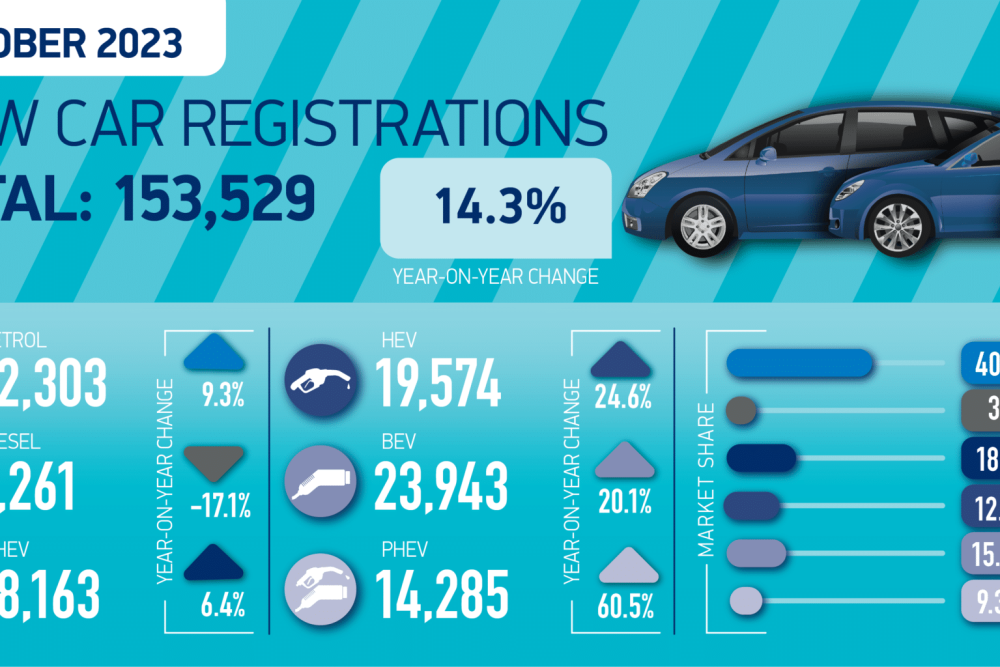ELECTRIFIED vehicle uptake continued to accelerate in October accounting for 37.6% of all new car registrations according to the latest figures from the Society of Motor Manufacturers and Traders (SMMT).
Hybrid electric vehicles (HEVs) grew 24.6% to reach 19,574 units, while plug-in hybrid vehicles (PHEVs) recorded the highest proportional growth, up 60.5% to 14,285 registrations. Battery electric vehicle (BEV) uptake increased for the 42nd month in a row, by 20.1% to 23,943 units. Given overall market growth, however, this amounted to a BEV market share of 15.6%, a relatively small rise from last year’s 14.8%. Furthermore, private registrations accounted for fewer than one in four new BEVs this year, underscoring the need for fiscal incentives for private consumers.
Year to date, BEV volumes have risen 34.2% to account for 16.3% of new registrations this year, up slightly from 14.6% this time last year.
October’s plug-in vehicle performance follows a significant increase in chargepoint rollout in Q3, which improved significantly relative to new plug-in car uptake. 4,753 new standard chargepoints came online in the quarter, the largest ever quarterly delivery.
This equates to one new standard public chargepoint being installed for every 26 new plug-in cars reaching the road between July and September, improved from 38 in the same quarter last year. However, installation was disproportionately focused on London and the South East, which received four out of five new chargepoints commissioned during the quarter – despite the region accounting for fewer than two in five new plug-in registrations during the same period. In comparison, just 13 chargers were installed in Yorkshire and Humberside, while the North actually had 105 chargers taken out of service.
With EV uptake greatly influenced by perceptions of chargepoint infrastructure availability and accessibility, action should be taken to ensure more equitable distribution and pricing for public charging. Reducing VAT on public charging to match home use would mean those unable to install their own chargepoint – typically those in flats, terraces and rented accommodation – would avoid paying four times the tax paid by those who can – typically those who own houses with off-street parking.
Binding targets for chargepoint rollout, in line with those set for the car market by the Zero Emission Vehicle Mandate and supported by the necessary changes to planning and grid connections so desperately needed, would also help accelerate installation, giving consumers confidence in being able to charge when and where needed.
Gav Murray, EV director at British Gas, said: “Making electric vehicles (EV) accessible for all drivers is a project that demands commitment from both government and industry. Pushing back the ban on new petrol and diesel cars has frustrated manufacturers, but the extra time means much-needed public charging infrastructure might be in a better place by 2035. Despite this, confirmation of the zero emission vehicle mandate from next year at least gives the industry the clarity it desperately needs to plan ahead.
“To keep the momentum going, it’s vital that industry leaders and policy makers boost incentives for EV adoption.”
Following a glut of new battery electric van (BEV) registrations in September, uptake was slower in October, down by a fifth (-20.2%) to 1,362 units – skewed in comparison with a particularly large fleet order in the month last year. In 2023 to date, BEV demand has risen by 19.8%, with 15,658 units registered since January.
These greenest vehicles represent one in 20 (5.5%) new LCVs so far this year as manufacturers continue to make net zero investments, having already delivered 27 different all-electric van models to market. Uptake rates will need to accelerate, however, and as the Zero Emission Vehicle Mandate comes into effect in less than two months, government must pull every lever to stimulate demand.
The Autumn Statement due later this month is a key opportunity to send a message that now is a good time to make the switch, by committing to retain existing incentives and beneficial tax frameworks for BEV buyers. Looking further ahead, it must also address major barriers to mass uptake, particularly by ramping up the rollout of public chargepoints which meet the specific needs of vans of all types and sizes.
Furthermore, by providing prompt legislative approval for driving licence derogations for LCVs weighing more than 4.25 tonnes, it will be easier for fleets to invest in the largest BEV vans, accelerating decarbonisation and improving air quality in every region of the UK.








